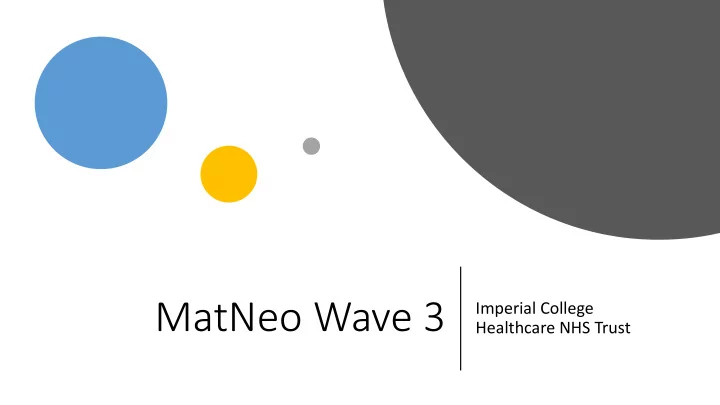

MatNeo Wave 3 Imperial College Healthcare NHS Trust
• Jenny Ziprin – consultant Neonatologist • Heather Liggins – midwife • Shree Koirala – midwife • Tom Prior – consultant Obstetrician
Bristol • We travelled to Bristol a little less prepared than other team • We got to know each other a little better • And got to know the program a little better
• We were encouraged to think big……..by making small changes Bristol learning set
We wanted a But, we also project that fitted wanted a project the framework of that involved all the collaborative areas of the team Developing our project Many of the So we put our change ideas were heads together things already and identified a being done well at problem……. our units
Risk factor Red flag Invasive GBS in previous baby Neonatal Maternal GBS in current pregnancy antibiotics Prelabour ROM Preterm birth <37 weeks • We felt that many of the PROM >18 hours babies prescribed Intrapartum pyrexia >38/suspected chorioamnionitis Antibiotics following delivery, were receiving Parenteral Abx given to mother due to suspected Yes them unnecessarily. invasive sepsis • We reviewed the NICE Confirmed infection in co-twin Yes guidelines – 2 risk factors or 1 red flag = Abx
Anecdotally we all felt that these guidelines were not being followed Many babies were being treated Neonatal leading to antibiotics • Longer admission for mother and baby • Potentially unnecessary and painful investigations for baby (eg. LP) • Stress for mothers • Increased Antibiotic use
Lack of awareness of the guidelines Defensive practice Why……Why Lack of communication between maternity/obstetric teams …….Why……. and neonatal teams – intra-partum pyrexia being interpreted as sepsis Why…….Why Culture Concern that babies would not be monitored appropriately
So we came up with an aim…. Improvement would lead to • Better maternal experience • Less investigation of baby Achieve that 100% of babies • Better awareness of true sepsis • Shorter admissions for mother and receive antibiotics for appropriate baby indications by June 2020. • Reduced ‘bed blocking’ on postnatal ward • Better flow of patients through the unit
And a plan……. • Firstly we needed to confirm we had a problem • We planned an audit of neonatal Antibiotic prescriptions over a 10 day period. • 75% of babies received Abx inappropriately 3 • Definite scope for improvement Appropriate Inappropriate 9
Next we developed our driver diagram Aim Primary drivers Secondary drivers Ensure guidelines for maternal Abx prescription are followed and intrapartum pyrexia and puerperal infection distinguished Reduce inappropriate prescription to mums Ensure guidelines for assessment of intra-partum pyrexia are followed with Antibiotic stewardship note Neonatal SHO to add to ‘Antibiotic stewardship’ note Ensure NICE guidelines documenting risk factors that Achieve that 100% of babies (Red/white flags) are followed necessitate ongoing neonatal receive antibiotics for Reduce inappropriate treatment appropriate indications by prescription to babies June 2020 Obs SHO to add specific Cerner Improve communication note titled ‘Antibiotic between Obstetrics and stewardship’ when neonatal team commencing Abx with indication documented NEWS to be used and Optimise neonatal monitoring documented by postnatal for signs of sepsis ward staff/neonatal team
Which needed to be revised following 1st Coaching Call.. Aim Achieve that 100% of babies receive antibiotics for appropriate indications by June 2020 Engagement in SCORE survey with feedback & debriefing Monitoring of Friends & Family survey and “ NeoTrips ” parental questionnaire Monitoring of Datix ‘s relating to antibiotic errors
Lets make a change • First PDSA cycle planned for week commencing 3 rd June
• Is communication a problem ? • Results will guide our next PDSA Aim to standardise communication and cycle indications for maternal and neonatal antibiotics. Act Plan • Was maternal temp measured and documented correctly • Was the Antibiotic Stewardship note Study Do completed on Cerner • Were maternal antibiotics prescribed in accordance with local/national guidelines • Obs SHO to create new Cerner note titled (1 temp >38 or two 1 hour apart >37.5) ‘Antibiotic stewardship’ whenever intrapartum • Did the Neonatal SHO add to ‘Antibiotic Abx are prescribed with indication for Abx. Stewardship’ note • Neonatal SHO to add to this note when • Were Abx prescribed/not prescribed in reviewing baby post delivery accordance with guidelines
SMH QCCH 3 1 2 5 Appropriate Inappropriate Appropriate Avoided AB Inappropriate Avoided 3 3 1 Stewardship 5 yes Stewardship no 3 3 yes n/a 5 no
Challenges • 3 labour wards on 2 sites • Definition of maternal sepsis not clear cut • Pulling denominator data from Cerner (EPR) • The private ward.. • Patient Experience • Locum staff
Recommend
More recommend